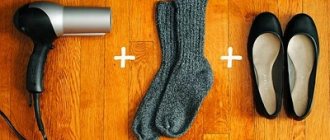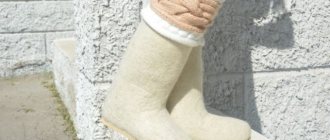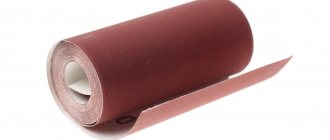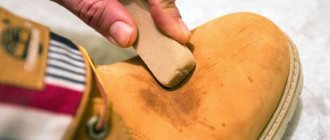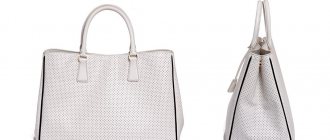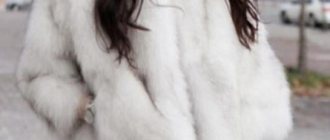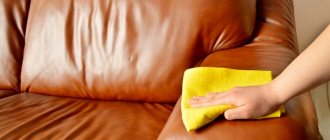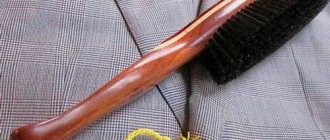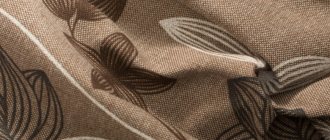Care Tips
Suede can be artificial or natural. Its surface consists of many fibers that deeply and quickly absorb water and dirt. There are general recommendations for caring for this material; by following them, you will avoid the need to use complex cleaning agents.
1) As soon as you have purchased a suede product, it needs to be treated with a product that repels water. There are many protective sprays available on the shelves of specialized shoe stores and supermarkets.
2) You should not wear clothes or shoes made of suede when it rains, because the material quickly absorbs water and swells, and then takes a long time to dry.
3) Do not try to use products intended for leather on suede items, they will only ruin the appearance.
4) Small fibers absorb not only water but also dust well, so it is recommended to use closed boxes, bags, and covers for storage.
5) Even if your shoes or clothes have faded over time, you don’t need to throw them away immediately; just buy special dyes for suede, which will easily return the product to its original beauty.
6) Do not dry your shoes on heating devices; instead, fill them with newspapers to absorb excess moisture and prevent deformation. Boots dry completely naturally in about a day, but hot radiators dry out the material too much.
Features of the material
Natural suede is made from the skins of large animals - elk, deer, roe deer, goats, sheep. To obtain a soft and fluffy material, the raw materials undergo step-by-step processing. Using the tanning method, the canvas is impregnated with special fats - fish, seal or vegetable oils. The surface then takes on a shiny, velvety appearance, looking expensive and stylish. Suede can be not only natural, but also artificial and synthetic. Below is a comparison of the characteristics of these materials.
| Characteristics | Natural | Synthetic |
| Price | High-quality expensive raw materials are used. The manufacturing process is long, so the price of natural products is high | Artificial materials are more affordable |
| Durability | With proper and timely care, it lasts a long time and does not lose its visual appeal. | Short-lived, wears out quickly and loses its original appearance |
| Practicality | It allows air to pass through, allowing the leg to “breathe” and retain heat. However, suede shoes do not tolerate moisture well and require special care. | There is no air circulation in artificial products and they do not retain heat during the cold season. Like natural suede, it wears out quickly in wet weather |
Shoes made from natural suede can be distinguished by the following characteristics:
- The surface is fleecy on both sides, there is no fabric base.
- When you run your hand over the surface of the material, it changes color slightly and shimmers.
- Pleasant smell of genuine leather, no chemical impurities.
- The finished product has raw edges. Artificial shoes always have special seams or adhesive to prevent them from fraying.
- If you put your hand on natural suede, the surface will quickly warm up.
We suggest you familiarize yourself with: The washing machine spontaneously drains water
The finished product has raw edges
How to clean dirt from suede shoes
The sooner you can clean your shoes, the greater the chance that the dirt will disappear without a trace and sometimes aggressive cleaning components will not harm the material.
1) It is recommended to clean suede items using dry methods, as the material takes a long time to dry and becomes rough. At the same time, many people take care of their shoes by wiping them with a damp sponge dipped in soapy water. To remove fresh and small dirt, this may be enough, but more often more serious means are needed.
2) If a regular sponge cannot cope with stains, then a melamine sponge will come to the rescue. This is a miracle product made from special rubber, which, like an eraser, removes stubborn stains without auxiliary chemicals, without damaging the surface. Some housewives claim that foam plastic successfully copes with dirt on suede boots.
3) Instead of sponges, a special rubberized brush is often used, which also acts on the principle of an eraser. Depending on the purpose of use, the movements of the brush may be different, so to remove abrasion it should be moved back and forth, and to eliminate dirt it should be moved only in one direction.
4) Old dirt on suede shoes can be easily removed with milk. Pour milk, a spoonful of soda and a couple of drops of ammonia into a mug. The solution is applied to the contaminated areas and then gently wiped off.
5) Dark suede material is tidied up using coffee grounds. It is applied to the product with a sponge and cleaned with a brush. After a few minutes, the residue is removed with gauze or wiped with a damp cloth.
6) Bread copes well with salty traces; the white coating is wiped with a crust of black bread and cleaned with a brush. This is a simple but effective way.
Remember, clean only dry shoes, otherwise the surface will quickly begin to shine and it will become impossible to restore its original beauty.
Useful video
Thanks to videos on the Internet, you can clean suede without resorting to washing in a machine. To do this, it is recommended to use improvised means. Don't forget about professional cosmetics for suede. Cleaning is done manually. Make sure to protect your hands in advance and wear gloves:
- Gasoline will remove the most difficult stains. First, use a brush to remove any chunks of dirt. Treat remaining stains with gasoline. Then wipe the problem areas with a cloth soaked in water;
- You can use crackers. Use a piece of white bread. Hold suede shoes over steam, and then treat them with a cracker. Once dirty, you can brush it. This must be done carefully, without pressure;
- Talc will also help remove dirt from suede. It will not spoil the material and will remove greasy marks. Apply the product to the product, wait 30 minutes and clean with a brush;
- It is recommended to use the following products to clean suede by hand: vinegar, ammonia and ethyl alcohol. Choose one of the products and dilute it with water. Then soak a rag in the resulting solution and apply to the suede product. Leave the shoes to dry. Don’t be afraid to use vinegar: it won’t ruin the suede and will cope with any stains;
- You can clean your shoes with sandpaper. However, it is better to use this option in the most extreme cases. The area of contamination must be treated very carefully. In addition, ethyl alcohol helps get rid of stains on suede. Soak a sponge in a solution of alcohol and water and apply to the problem area;
- If your suede shoes are brown, coffee grounds will help remove stains. After using this product, the product should be treated with a rubberized brush. Do the cleaning slowly. Move in the direction of the pile. This way you won't damage the suede.
Important! Be extremely careful when cleaning suede products that are damaged in the area where the upper is glued to the sole.
Cleaning shiny suede shoes
Shiny suede shoes can be restored using several methods.
1) The easiest and fastest way is to hold the product over a boiling pan or treat it with steam; you can also rub it with an eraser. Such manipulations allow you to raise the pile.
2) Ammonia works well for scuffs on shoes; to do this, dilute alcohol in water in a ratio of 2:1. Dip a clean cotton pad or gauze into the resulting liquid, and then thoroughly wipe the problem areas.
The remaining product is washed off with a small amount of plain water, after which the shoes are treated with a brush dipped in a mild vinegar solution.
3) Finally, you can raise the pile using fine-grained sandpaper, just work the worn area, but do not overdo it, so as not to completely ruin the shoes.
Dry cleaning
If possible, it is better to use the dry cleaning method, since suede really does not like to come into contact with water. A large amount of moisture causes the pile to stick together and spoil its appearance.
- In case of dry contamination, it is enough to work with a brush to return the shoes to their previous condition.
- To clean suede from dust, any soft brush or even a sponge will do.
- Ideally, use a special rubberized brush for suede or a brush with natural bristles.
- People use dry bread crust.
After brushing, it is advisable to hold the shoes over hot steam to restore the fleecy layer. Alternatively, you can use an electric steam cleaner for this purpose.
Removing greasy stains from suede shoes
Housewives often have questions about how to clean oily stains from suede shoes without damaging the material. Talc and gasoline help well in this matter. You need to moisten the dirt with gasoline and sprinkle talcum powder on top. Leave the shoes for at least an hour and a half for the gasoline to take effect. After the specified time has passed, walk over the surface with a coarse brush.
Good alternatives to gasoline for old grease stains include salt, tooth powder, and chalk. The grains are poured directly onto the dirt in a thick layer, and you just have to wait until they absorb all the fat. If necessary, the procedure is repeated several times.
You can also make a special cleaning foam at home against old stains. To do this, mix warm water, two tablespoons of ammonia and simple liquid soap in a closed container. All ingredients are thoroughly shaken until a foamy head forms.
A small rag made of soft fabric is immersed in it, with which you need to carefully clean the shoes. At the end, the cleaned shoes are rinsed with water and vinegar.
How to clean nubuck? Are there any differences in care for suede?
Nubuck is not very different from suede; the same products are often used for care. Boots made from this material cannot be washed or washed; under no circumstances should detergents or soap be used, as the shoes will be damaged. Treatment with water-repellent sprays is mandatory, which will provide protection from moisture and preserve the beautiful appearance of the shoes.
Also, when cleaning, you should not use products such as ammonia and other non-professional products. All dirt should be removed immediately; dirty nubuck shoes should not be left until the morning.
For daily care, you can use soft brushes that restore the direction of the pile and make the surface neat and velvety.
To maintain the beautiful appearance of suede, you need to start caring for your shoes immediately after purchase. It is recommended to treat the surface with dust- and moisture-proof impregnations, immediately remove dust and dirt, and dry wet boots.
Stages of daily care for suede shoes at home:
- Drying. To do this, you can stuff your shoes with old newspapers.
- Cleansing. Contaminants should only be removed from dry suede, as otherwise the stains can be “rubbed” into the material even more, thereby ruining it. To clean, you need to use special brushes for suede. Movements should be non-aggressive, in one direction. Circular ones are prohibited to avoid damage to the pile.
- Coloring (carried out if necessary). If the color coating begins to fade or bald spots appear, you can use special sprays. They need to be sprayed, like water-repellent ones, at a distance of at least 30 cm, over the entire surface of the product, and not just in the place where the bald spot has formed. This will help avoid uneven coloring. After painting, suede shoes should dry for one to two hours.
- Moisture protection. Water-repellent sprays must be used regularly, as they also create a reliable barrier against other negative factors (dust, dirt). Shoes treated with such means are better stored in the closet and do not become moldy.
Caring for nubuck shoes is practically no different. This material is made of genuine leather, reminiscent of suede, only it is finer-haired and tolerates moisture better. There are also special products for nubuck products: moisture protection and coloring sprays, brushes, erasers for removing stains, napkins and others.
Cleaning dry shoes
There are many care products for suede shoes that help keep them in good shape and extend their service life. The main ones:
- Water repellent sprays. This is a basic product that should be in every home. The spray should be used regularly, several hours before leaving the house. It creates a protective film on suede, protecting it not only from moisture, but also from dust, dirt, and street reagents. Among the disadvantages, users note a pungent odor and the inability to use in a confined space.
- Spray paints. There are two types - with moisture protection and intended only for color renewal. Their disadvantage is the need to select boots, boots, shoes in accordance with the shade.
- Cleaning foams. Spray on shoes, shoes, boots, then carefully remove with a soft sponge or napkin. The foam absorbs various contaminants, so there is no need to use mechanical force during cleaning; as a result, the fleecy layer is not damaged. According to consumers, such products do not remove severe stains well and are too expensive.
- Dry shampoos for suede that return the product to its original appearance. No deficiencies identified.
- Stretchers. Used for tight shoes that have not yet been worn in, to avoid the appearance of calluses on the feet and make them more comfortable to wear. Disadvantage: they do not have an immediate effect; stretching takes some time.
It is better to purchase these products at the same time as your shoes, since caring for suede should begin immediately. There are many brands of different price ranges, so the choice is extensive, for every taste and budget. Shoe manufacturers do not recommend saving on care products.
Cleaning foams
Methods for removing whitish spots on suede shoes
Whitish spots on suede appear from dampness and improper care, so we note once again that it is not recommended to wear suede shoes in inclement weather. If the rain suddenly caught you and your shoes got wet, then you definitely need to stuff them with newspapers and dry them away from the radiator and other heaters. The boot should be positioned so that the sole is also dry.
How to clean white residue from suede shoes? You can refresh the product and return it to a neat appearance using steam treatment. Place a large container of water on the burner and wait until the liquid boils; prepare a rubber or bristle brush in advance. As soon as the water boils, you need to reduce the heat and hold the suede item over the steam; quite quickly the material will heat up and become slightly damp. Carefully walk over it with a brush, repeat the action several times if necessary. After finishing cleaning, set the shoes to dry.
If you have a steam generator or iron at home with a built-in steam function, then you don’t have to boil water, but use these devices.
It happens that suede, on the contrary, darkens when wet, this indicates that the pile has deteriorated irrevocably. It is impossible to change the color mechanically, and the only way to correct the situation is to paint the shoes with special paint.
How to care for suede boots
You need to clean suede shoes after every trip outside so that dust and dirt do not have time to be absorbed. If this happens, it will be difficult to clean the shoes. If the weather is clear, then it will be enough to simply clean your shoes with a special suede brush.
If the weather is rainy and the shoes are wet, then they must first be dried. Moreover, this must be done in natural conditions, and under no circumstances should it be placed near a heater or radiator. In this case, the suede may warp and the shoes will lose their attractive appearance.
After the shoes are dry, they should be cleaned with a suede brush. It performs 2 functions at once - it removes dust and raises lint. If you don’t have such a brush, you can use a school eraser.
How to remove salt from suede shoes
You should start treating your shoes after they have dried.
There are several ways to deal with salt.
You can prepare the mixture: 0.5 tsp. ammonia, 1 tbsp. l. Dilute liquid soap in a glass of water and foam. Apply the resulting mixture with a sponge to the contaminated area. After some time, remove the foam with a soft cloth. After this, wipe the shoes with a solution prepared from 1 liter of water and 1 tbsp. l. vinegar and let the shoes dry.
Salt stains from suede shoes can be removed with steam.
If the shoes are very dirty and the stains cannot be removed, pick up a can of paint that matches the color of the shoes and return them to their original appearance.
How to clean dirt from shoes
Before you decide to clean your suede shoes, remember that dirt can only be removed from dry suede. To prevent your shoes from losing their shape after cleaning, push some paper inside and place them to dry away from heating devices.
After the shoes are dry, remove dirt from their surface with a stiff brush. You can lift the pile with the rubber side of the brush.
What if, for example, glue got on the suede? You can remove it with a cloth soaked in gasoline and only if the glue has not yet hardened. And if it has already dried, you can try to carefully scrape it off with a blade and wipe the dirty area with nail polish remover.
If grease gets on the suede, you can remove it with dishwashing liquid. To do this, mix a small amount of liquid with water, beat until foamy and apply to the stain. After 1-2 minutes, remove the remaining foam with a soft, dry cloth.
Cleaning suede shoes from salt stains
Suede boots are considered very warm, so women often wear them in winter. Unfortunately, upon arriving home, you can find stains of salt and reagents on your shoes, which utility services generously sprinkle on the asphalt.
Although salt helps in cleaning suede material, such as oil stains, it also leaves marks and breaks down the lint, thus reducing wear time. Therefore, salt stains should be removed as quickly as possible.
As soon as you get home, wipe the white areas with undiluted vinegar, and then dry the boots completely. Don't forget to brush the surface with a rubber brush.
If simple cleaning does not help eliminate white marks, then dilute liquid soap in water. The mixture is applied to the surface with a clean, slightly damp sponge; remember that suede items do not like excess moisture. Once the shoes are dry, comb out the lint.
How to clean properly
To ensure that your shoes last a long time, you should definitely study tips for cleaning suede products depending on the type of contamination. You can use both professional compounds, tools, and proven grandmother’s methods. Home remedies are not as effective as special ones, but they are always at hand.
From dust and dirt
Dust and dirt are easily removed with special brushes, which should be used without much pressure in one direction. Cleaning is carried out only on completely dried products. If dirt is not removed using this method, the shoes can be held over steam for 1-2 minutes, then repeat the process. In this case, it is better to use a metal brush. Foams and shampoos from the Twist, Kiwi, and Ecco brands are well suited for cleaning.
From stains
Greasy stains can be removed with special suede erasers. If this does not help, it is recommended to use gasoline (wet a rag with it and wipe the surface). However, this method has a significant drawback - an unpleasant odor that takes a long time to dissipate. Vanish stain remover is suitable for ready-made products, especially for old stains. After using it, the marks can be painted over with Famaco Renovateur Daim spray. Dry items as usual, away from radiators and sunlight.
If the suede is shiny, baking soda dissolved in milk will help. You can also use soapy water or ammonia. After cleaning, shoes should be dried in an open space, avoiding direct sunlight, but in a well-ventilated area. This method is applied regardless of what stains were removed and how. After such wet cleaning, the pile may become wrinkled. It should be lifted with special brushes for suede from trusted manufacturers.
First, pay attention to the purpose. If the impregnation contains fats, it cannot be used for suede, but is recommended for leather.
The release form does not affect the composition; only personal preferences play a role here. Aerosol is convenient to use, but it is used up very quickly. You'll have to tinker with the wax, but one jar will last for six months.
Among the undisputed leaders producing truly high-quality impregnations for shoes, there are 5 main ones:
- Salamander;
- Salton;
- Nikwax;
- KIWI;
- Collonil.
Before using the shoe protection product, you must thoroughly clean the surface of dirt and dust. This is done using special brushes, the choice of which depends on the material used to make the shoes or boots. The leather surface can be wiped with a damp cloth and then dried thoroughly. Further actions include these simple steps:
- you need to read the instructions for the aerosol - different manufacturers may give different recommendations - these are the treatment height, drying time after application and other nuances;
- the spray is usually sprayed at a distance of no less than 10 cm from the surface of the shoe, this should be done with even movements, trying not to apply too much of the product and prevent drips from appearing;
- the spray is applied to the entire surface of the shoe, but it is recommended to protect metal objects and fittings (for this you can use paper napkins);
- After treatment, you should wait until the product dries; if necessary, the treatment is repeated;
- You can wear shoes 30-40 minutes after treatment.
Water-repellent sprays are used to effectively protect leather, suede, membrane and textile shoes from liquid dirt or water. Some products additionally provide protection from salt in winter, preventing the appearance of whitish stains and coarsening of the material. Using sprays is not difficult, they are applied to the surface of cleaned shoes, the frequency is approximately every 2-3 weeks.
Cleaning light-colored shoes
Light suede shoes need regular cleaning. As soon as stains appear on the surface and it becomes untidy, wipe the dirty areas with a cotton pad soaked in ammonia or peroxide. The stronger and older the contamination, the more concentrated the solution should be. Please note that cleaning with concentrated ammonia or peroxide should be carried out no more often than once every six months.
Sometimes a stiff brush or a clean piece of rubber is enough to remove salt and reagents. If there is no result, then you need to add a little vinegar, and then comb the dried shoes with a brush.
Light suede can be cleaned well with a crumb of white bread; you need to roll it into a ball and lightly wipe off the dirt. Do not press too hard so that the pile does not lose its velvety quality.
The following mixture works great for removing dirt on white shoes: one teaspoon of soda, 100 ml of milk and a few drops of ammonia. Soak a cloth in the solution and wipe away the dirt.
How to get rid of heavy dirt?
How to wash suede shoes without getting them wet? During wear, suede boots can become much more contaminated than just dirt after rain. The following folk remedies will help you cope with them:
- Starch (corn or potato) or regular talc will help remove a greasy stain. To do this, you need to sprinkle the product on the stain and leave the shoes in this condition for at least 6 hours. After this, all that remains is to shake the remaining product and clean the shoes with a brush.
- Medical ammonia will help remove severe contamination. To do this, dilute a few drops with water and remove the dirt using a sponge. You can wash off the solution with a damp cloth.
Important! After drying, the shoes must be treated with a weak solution of vinegar, which will restore the elasticity of the suede.
- A solution of baking soda, a teaspoon of which should be diluted in a glass of warm milk, will help remove an old stain. Use a sponge to wipe away dirt, and then remove the solution with a damp cloth.
How to remove grass marks
It is believed that suede shoes are very warm and are usually worn in the winter, but some fashionistas willingly wear shoes made from this material in the summer.
Sometimes after a walk you can find unsightly marks from the grass on your shoes. If the stains are fresh, they can be easily removed with vodka or denatured alcohol. This is a mixture of ethyl alcohol with a small amount of kerosene and methanol. In some cases, a salt solution helps, one teaspoon mixed with half a glass of warm water.
How does water repellent spray work?
The operating principle of water-repellent products is simple: the product creates a protective layer on the surface that prevents moisture from absorbing into the material. Thus, Invulner spray with fluorinated and fluorocarbon resins in its composition creates a neutrally charged invisible film on the surface.
Water-repellent agents are necessary for shoes of any type, but they are especially important for suede and nubuck if they are worn in rain or sleet. Under the influence of water, these materials quickly deteriorate, losing their novelty and attractiveness.
When purchasing a spray, it is important to consider what material it is intended for. Manufacturers offer a range of products for leather, nubuck, textiles and other materials, differing in their operating principle and properties. In addition, sprays are available for simple protection from water, use in winter, and protection of shoes from salt mixtures used to sprinkle roads.
Each surface is characterized by special properties:
- Hydrophilicity. The liquid spreads over the entire surface and gets into all corners of the product.
- Hydrophobicity. Water is not absorbed, but collects in small drops on the surface.
A water-repellent spray for suede, leather and other types of natural materials must be used. These materials are classified as hydrophilic. At the same time, there are small pores on the surface of these materials, the ingress of water into which can damage the entire shoe.
You should not choose cheap products, as they create a film that does not allow your feet to breathe. It is better to opt for a hydrophobic product that forms a safe protective shell. Their cost varies from fifty to three thousand rubles.
Purchased funds
Not everyone likes to tinker with homemade mixtures, so supermarkets and shoe stores stock a lot of products for caring for suede shoes.
1) It is recommended to treat glossy or faded shoes with a special paint; the main thing is to purchase a bottle with a suitable shade.
To choose the right color, you should spray a little paint on the inside of the boot or shoe. Please note that the shade will not be accurate on other surfaces. In shoe stores, experienced consultants are able to quickly and correctly select the appropriate spray can. If there is no identical paint, then do not take even a very similar shade, so as not to be disappointed with the result.
2) Water-repellent spray not only protects shoes from water, but also helps keep the product clean. The components included in the spray form an invisible greasy film that prevents dirt from getting inside the fibers, so a brush and cloth are enough for cleaning.
There is nothing complicated in using store-bought products, because manufacturers write detailed instructions on how to clean suede shoes right on the bottles. Usually you need to shake the can well and spray the liquid over the surface to be treated; as soon as the foam dries, all that remains is to work with a brush.
Rules for cleaning suede shoes
To effectively protect the suede surface from dirt and moisture, you need to buy a series of special products that provide care at every stage of wear.
If you don’t have time for care, but there are a lot of suede shoes in stock, then you should definitely purchase universal protection against moisture and dirt, which will make a pair of shoes always neat and at the same time refresh the color. Such sprays are slightly more expensive, but are multifunctional.
A new pair of shoes should always be treated with a protective spray. This must be done even if you are not going to get wet in the rain. The fact is that the structure of natural suede actively absorbs pollution from the surrounding space. Therefore, all the dust on a new pair of shoes without treatment will fall on its surface, making the surface untidy and dirty.
All care products must be used within their expiration date. After its expiration, the product must be replaced.
Do not use leather creams or impregnations on suede. The different structure of these materials and their appearance require different care products.
How to properly care for suede shoes in winter? Various methods are used for this, it all depends on the degree and type of contamination:
- Dust. When you walk, the surface of any shoe becomes covered with dust. Gradually it accumulates, the surface becomes dull and sloppy. Getting rid of dust is quite simple; you need to dry the shoes, then treat them with a soft brush, removing all traces of dirt. After cleaning, you can treat your boots or boots with a special spray that will prevent dust from accumulating in the future. To clean, you can also use suede foam, cover it with it and leave it for about 10 minutes. The next step is to remove dust with a brush.
- Water and liquid mud. In winter, it is not uncommon for shoes to become dirty with melted, dirty water, leaving unsightly stains on the suede. Of course, suede is a waterproof material, but the surface easily deteriorates when in contact with a liquid environment. Therefore, immediately upon returning home, you need to dry your boots, remove dry dirt with a brush, and, if necessary, treat them with special foam. Suede shoes should not be washed or wetted excessively, as the surface will be seriously damaged. To protect against water, you can use water-repellent sprays that impregnate the material. Such products do not allow water to be absorbed; all moisture simply rolls off the surface, leaving no traces.
- Dry dirt. Often, when wearing suede shoes in bad weather, dirty marks remain on the surface. You can remove such stains with a regular soft rubber or leather brush or a special eraser for suede. When mechanically cleaning, it is not recommended to press hard on the surface, as this may damage the pile.
- Oily spots. You can completely remove traces of grease from suede using a shoe cleaner, such as Saphir Omnidaim shampoo. On the Internet you can find advice on using potato starch, talc and ammonia. We are against the use of household products, as they can damage suede and worsen not only its appearance, but also its properties.
If you have any doubts about how to care for suede shoes, you can choose any method, regardless of whether natural or artificial raw materials are used. Boots, boots and shoes made of this material are not suitable for wearing in wet weather. According to the rules for caring for suede shoes, dry cleaning or minimal wetting is recommended. Sequencing:
- Use special brushes or napkins to clean off dirt (dust, dirt, stains). Mechanical impact should be minimal so as not to damage the pile and paint.
- Treat with sprays (to maintain color, water-repellent). It is prohibited to use water-based products. Salt or alkaline solutions are also not suitable for suede; they corrode the natural material. Do not use smooth skin care products.
- Leave the shoes to dry, preferably in an open place. It is necessary to ensure that it is not exposed to direct sunlight to avoid fading of the material. Suede does not tolerate high temperatures, so it is forbidden to place shoes on radiators or heaters. The material may crack and become rough.
It is best to store suede products in cardboard boxes. Plastic bags are not suitable for such shoes. The general rules listed above also apply to products made from artificial materials.
Clean dirt with special brushes or wipes
Store-bought foams and sprays
It is strictly forbidden to clean nubuck with chemicals that have an oily and viscous consistency.
The stores offer a wide and varied selection of sprays, as well as light foams.
There are several effective means:
- Loake Suede and Nubuck Cleaner. It delicately removes greasy stains, as well as various stains on the material. The product has a light foam structure.
- Balm Medaille D'or Nappa. To keep suede soft, you need to use a moisturizing conditioner. It helps soften and restore the material.
- Saphir treatment and protection spray. It is suitable for processing leather and nubuck. After cleaning, it is necessary to thoroughly spray the product so that a water-repellent protective layer is formed on the surface of the suede.
To extend the life of suede and nubuck, you can use Loake. It prevents premature wear of the material.
After treatment, a reliable protective layer appears that repels water and moisture, so the suede does not become hard for a long time.
Rules for cleaning suede shoes
Shoes made of light suede look luxurious and elegant, but are not suitable for everyday wear and are very impractical. Dust and dirt easily stick to it, and you can also quickly get stains. At the same time, cleaning should be delicate, since the results of incorrect actions will be more noticeable than on dark shoes.
Dry and wet methods are used to remove stains. The latter should be resorted to only in extreme cases. To remove stains of dust and dirt, a regular office eraser will do if you don’t have a special one. All they have to do is rub the dirt, and eventually the dust will start to roll off.
To remove greasy stains, you can use talc or starch. They will absorb the oil. But these products are not suitable for old greasy stains. For wet cleaning, use milk, hydrogen peroxide, and ammonia. They are quite effective, every housewife has them. You can prepare a simple solution based on hydrogen peroxide and ammonia in the following proportion: 1 teaspoon of these products per 1 glass of water. Moisten a sponge or soft cloth in the resulting liquid, squeeze well and rub the stain.

